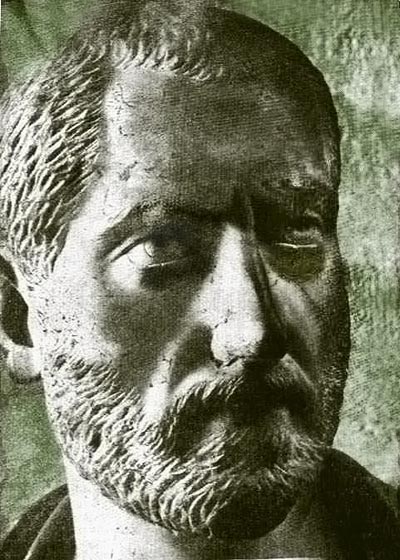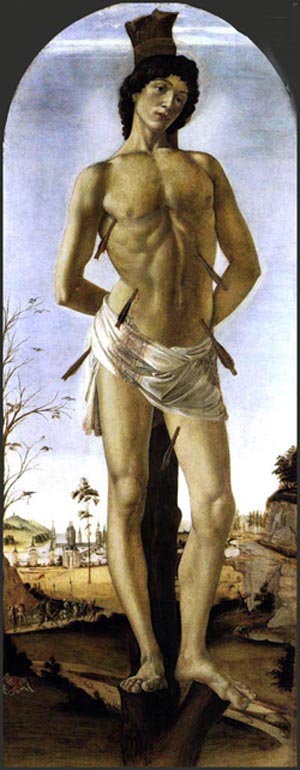Ambiences and Tendencies
 |
 |
 |
 |
 |
 |
 |
Pagan Manliness & False Christian Patience
If we compare the features of this third century Roman – represented in a splendid sculpture preserved in the Capitoline Palace – with those of the famous Apollo of Belvedere, the roughness of the former appears immediately. From this point of view, one could not say with full accuracy that it is a handsome man.
 Nonetheless, no one can deny that a certain sense of beauty issues from the conjunct of the physiognomy. But it is principally a moral beauty. The shape of the face and conformation of the skull are very proportionate. The forehead, ears, eyes, nose and mouth fall into line together perfectly. Each of these features gives an impression of proportion, strength and regularity, which find in the gaze their highest and most vivid representation.
Nonetheless, no one can deny that a certain sense of beauty issues from the conjunct of the physiognomy. But it is principally a moral beauty. The shape of the face and conformation of the skull are very proportionate. The forehead, ears, eyes, nose and mouth fall into line together perfectly. Each of these features gives an impression of proportion, strength and regularity, which find in the gaze their highest and most vivid representation.
It is the limpid, serene and serious gaze of one accustomed to analyzing the world with a sense of dominion and confidence in his own resources; this is truly admirable. It is a gaze that reveals the soul of a manly temperament, able to stand the trials and vicissitudes of life with strength and nobility.
Such was the Roman everyone knows. And these were the qualities he knew how to communicate to his great achievements: the Empire, law, and the masterpieces of his literature and art.
But if such was the Roman in general, it represents the Roman military in particular. Because they possessed the qualities of the people in high concentrations, the Roman armies dominated the world.
*
St. Sebastian, who lived in the same third century, was the commander of the personal guard of the Emperor under Diocletian and Maximillian. This was the elite troop of the army, which represented, from the point of view of virility, in its turn, the elite of the people. We know of no historical document that can enlighten us on the true physiognomy of this glorious Martyr. But everything leads us to believe that he would be much more serious and strong than the anonymous Roman in the first picture.
 This is so because St. Sebastian was Catholic, and grace, which elevates and fortifies nature, far from weakening the virtues of the Roman, gave them an incomparable value and intensity.
This is so because St. Sebastian was Catholic, and grace, which elevates and fortifies nature, far from weakening the virtues of the Roman, gave them an incomparable value and intensity.
How, then, can one admit that the noble chief officer of the palace guard of the Emperors could resemble this young man, at right, who, although riddled with arrows, appears like the antithesis of Christian mortification and seriousness of spirit?
This is a youth comely of face and body, very assured of his good looks and delighted to show them off. His face has a sentimental and capricious expression. The attitude of his body is that of one indolently enjoying the sun and breeze, somewhat weary of standing. He uses the tree trunk as a secure backrest, and adroitly found a way to comfortably support his feet on the two sawed-off stumps. The arrows do not cause him the least pain.
Nothing in this figure gives us the impression that he will die. The thought of God and eternal life, the supplication for final perseverance, the prayers of the Holy Church, a salutary invective or word of kindness to his tormentors, none of this is expressed or represented in this picture.
One could say that this young man, bored with finding himself alone, is just waiting and hoping that someone will find him so that he can return to the affairs of everyday life. In the final analysis, it is a morally mediocre person, concerned only with himself and the world... as long as the latter has to do with him. He belongs to the morally banal family of souls.
Artistically, it is a great painting, which, incidentally, is owed to the immortal brush of Botticelli. But the master should not have titled it "St. Sebastian." Better if he would have deleted the arrows, set the youth at ground level, and called the picture "Good-Looking Youth Sunbathing."
*
Why these comments? To make you sense the great evil that the pagan Renaissance did to souls, diffusing with its art an impalpable but contagious state of spirit that contradicted all the ideas of the Church on moral perfection.
Also, let them serve as a warning for today's Catholics who face much more serious aberrations of innumerable modern artists.

Published in Catolicismo n. 73, January of 1957
Posted September 18, 2013

It is the limpid, serene and serious gaze of one accustomed to analyzing the world with a sense of dominion and confidence in his own resources; this is truly admirable. It is a gaze that reveals the soul of a manly temperament, able to stand the trials and vicissitudes of life with strength and nobility.
Such was the Roman everyone knows. And these were the qualities he knew how to communicate to his great achievements: the Empire, law, and the masterpieces of his literature and art.
But if such was the Roman in general, it represents the Roman military in particular. Because they possessed the qualities of the people in high concentrations, the Roman armies dominated the world.
St. Sebastian, who lived in the same third century, was the commander of the personal guard of the Emperor under Diocletian and Maximillian. This was the elite troop of the army, which represented, from the point of view of virility, in its turn, the elite of the people. We know of no historical document that can enlighten us on the true physiognomy of this glorious Martyr. But everything leads us to believe that he would be much more serious and strong than the anonymous Roman in the first picture.

How, then, can one admit that the noble chief officer of the palace guard of the Emperors could resemble this young man, at right, who, although riddled with arrows, appears like the antithesis of Christian mortification and seriousness of spirit?
This is a youth comely of face and body, very assured of his good looks and delighted to show them off. His face has a sentimental and capricious expression. The attitude of his body is that of one indolently enjoying the sun and breeze, somewhat weary of standing. He uses the tree trunk as a secure backrest, and adroitly found a way to comfortably support his feet on the two sawed-off stumps. The arrows do not cause him the least pain.
Nothing in this figure gives us the impression that he will die. The thought of God and eternal life, the supplication for final perseverance, the prayers of the Holy Church, a salutary invective or word of kindness to his tormentors, none of this is expressed or represented in this picture.
One could say that this young man, bored with finding himself alone, is just waiting and hoping that someone will find him so that he can return to the affairs of everyday life. In the final analysis, it is a morally mediocre person, concerned only with himself and the world... as long as the latter has to do with him. He belongs to the morally banal family of souls.
Artistically, it is a great painting, which, incidentally, is owed to the immortal brush of Botticelli. But the master should not have titled it "St. Sebastian." Better if he would have deleted the arrows, set the youth at ground level, and called the picture "Good-Looking Youth Sunbathing."
Why these comments? To make you sense the great evil that the pagan Renaissance did to souls, diffusing with its art an impalpable but contagious state of spirit that contradicted all the ideas of the Church on moral perfection.
Also, let them serve as a warning for today's Catholics who face much more serious aberrations of innumerable modern artists.

Published in Catolicismo n. 73, January of 1957
Posted September 18, 2013
______________________
______________________








